
5 things to know about Winnipeg’s big sewage problem
115 billion litres, 70 years to fix, $5.5 billion in lawsuits
Back in the 1950s and ’60s, when Paul Fisher was growing up, the rural community of Snow Hill in Sampson County, North Carolina, was a welcoming, predominantly Black, working-class area. Fisher played baseball and joined a Boy Scouts troop, fished in local streams and hunted for rabbits and squirrels in the woods.
“Everybody knew everybody, and it was nice,” says Fisher, now 75.
Most of his neighbours owned modest plots of farmland. His family, too, had a farm, where they grew cotton, tobacco, peanuts, wheat and oats, and kept a garden.
After high school, like many of his peers, Fisher left Snow Hill in search of work. By 1975, when he came back home to settle with a young family in tow, a landfill had opened up in the community. Residents put up with it at first, since no one really knew what its impact might be, Fisher says.
But when it expanded into a regional landfill in the early 1990s, he and other community members became concerned.
Over the next decades, the landfill grew, undergoing ownership changes. Then, in 2018, a merger brought the landfill under the ownership of Canadian waste management giant GFL Environmental Inc.
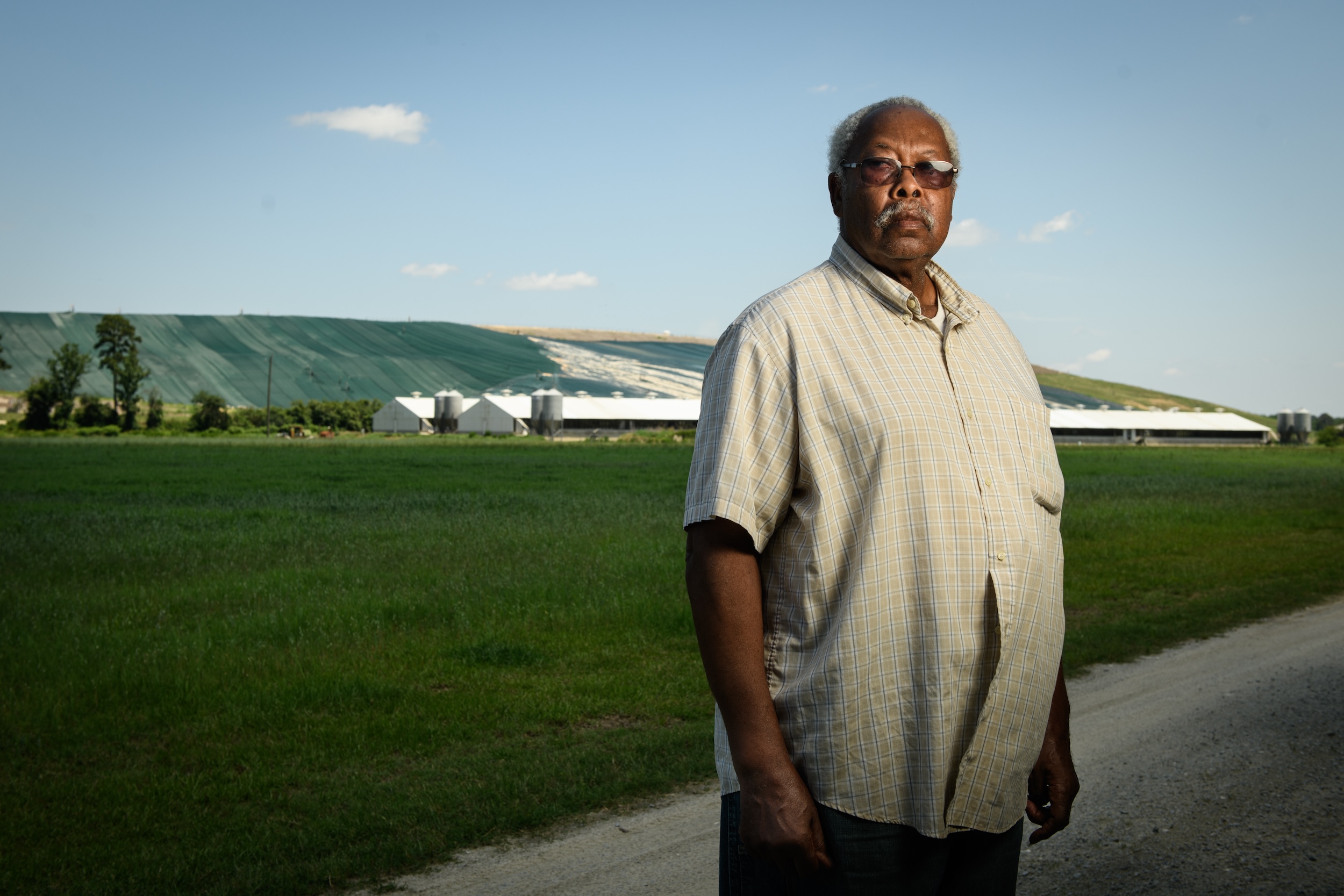
Headquartered in Vaughan, Ont., GFL is a major player in the North American waste management sector, offering services from collecting waste and running landfills to operating oil refineries and responding to hazardous spills. Starting in southern Ontario in 2007, it has aggressively expanded since. It now employs more than 20,000 people and operates in much of the U.S. and across Canada, including in about 40 cities and communities in Ontario.
A February notice of intent to sue the company from the non-profit Southern Environmental Law Center alleges that since GFL acquired the Sampson County landfill, the volume of waste that the landfill accepts has surged. A lawyer representing GFL did not reply to The Local and The Narwhal’s requests for a response to the notice of intent to sue. None of the Southern Environmental Law Center’s allegations have been proven in court.
What was once a 15-acre operation is now one of the largest landfills in the state, covering roughly 1,000 acres (about 400 hectares), and it is expected to swell to 41.6 million tons (37.7 million tonnes) of trash by 2043, the letter alleges. And those living in its vicinity are paying the price. Snow Hill is no longer the idyllic rural community of Fisher’s memories.
The stench, he says, is “outrageous.” Turkey vultures, or buzzards, hover around the neighbourhood, leaving their feathers and droppings wherever they roost. On occasion, Fisher says he’s had to shoot his gun in the air to deter them from landing on his neighbour’s roof, where they tear off the shingles. And Snow Hill is no longer the close-knit community it once was.

The Southern Environmental Law Center’s letter depicts a once-vibrant community that has now become spiritless and polluted. Residents deal with contaminated well water, truck traffic, trash blowing onto their property and pervading odours, the letter says. “Described as a ‘clammy miasma,’ and a ‘greasy, oily’ smell ‘like decaying flesh,’ the odour from the landfill wakes people up at night, stops adults from gardening and children from playing outside and ruins social events like cookouts and church gatherings,” it alleges.
Roughly 1,100 kilometres away, in Northville Township, Michigan, David Drinan and Leslie Evans are dealing with similar issues, living downwind of the Arbor Hills landfill, a site acquired by GFL in 2020. They, too, describe being beset by constant odours, noise and traffic congestion from trucks hauling waste, as well as contamination of the area’s only cold-water trout stream. Their citizens’ group, The Conservancy Initiative, is fighting GFL’s plans to open a new landfill adjacent to its existing one.
Meanwhile, across the Canada-U.S. border to the east, residents near GFL’s Stoney Creek landfill in Hamilton, Ont., say they’re fed up with the fetor that suddenly became so pervasive and vile last year they couldn’t open their windows or spend time outdoors for most of the summer.
Even though the smell died down over the cold winter months, it had returned intermittently early this spring.
“Still, you can feel it,” says homeowner Nelson Faria — a sickening pong that lingers in the back of your throat.
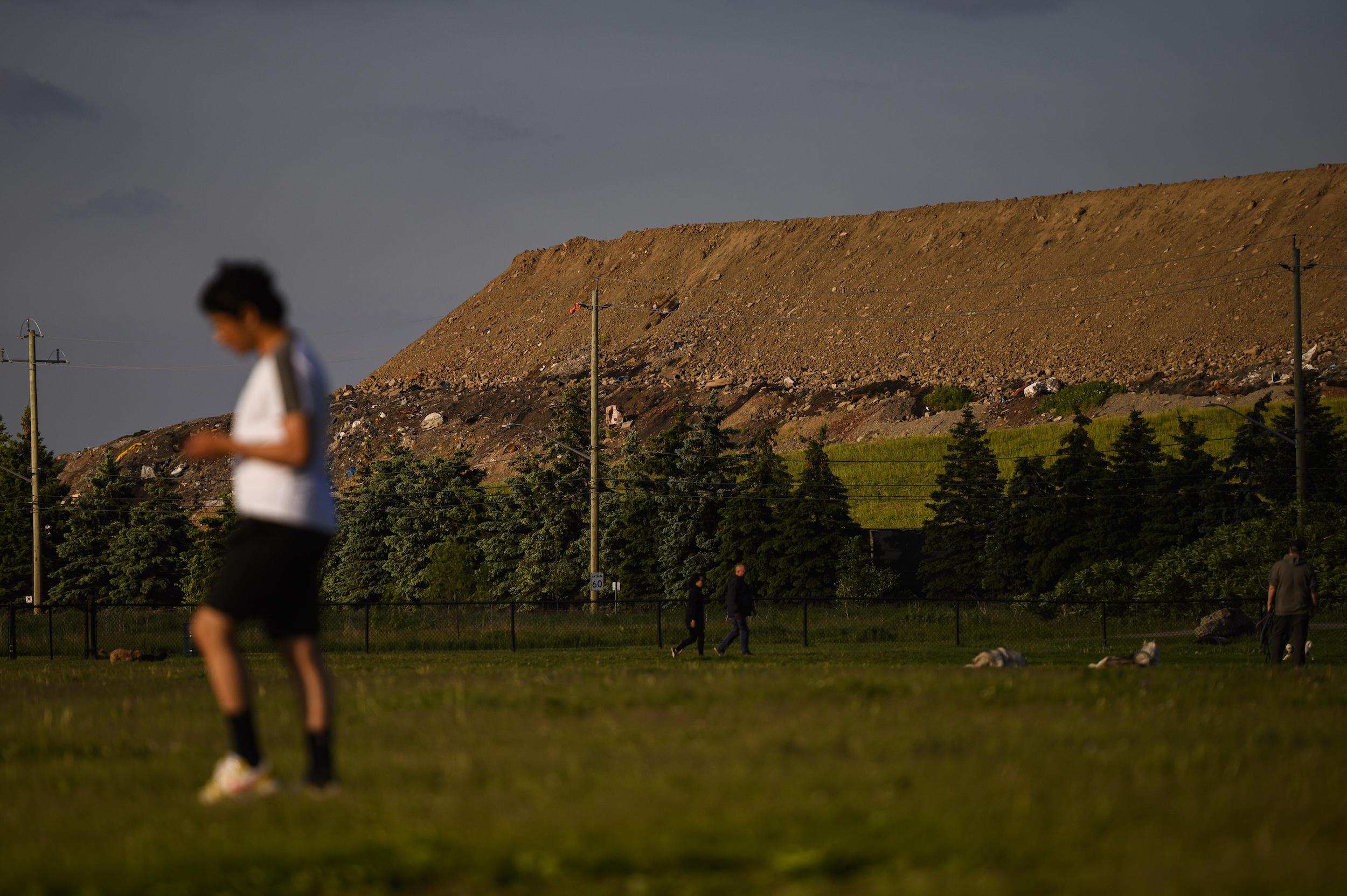
The firsthand experiences of the people who live near waste operations owned by GFL and its subsidiaries stand in stark contrast to the company’s eco-friendly image. Green, specifically the vivid shade associated with freshly sprouting leaves and used in the company’s logo, is the colour that makes GFL’s garbage trucks instantly recognizable. It’s also literally in the name, Green For Life.
“GFL’s vision is to be green for life. It’s as simple as that,” Patrick Dovigi, the company’s smiling chief executive said in a 2022 video, produced for a business campaign on sustainability called Vision 2045.
GFL refers to its employees as “Team Green.” It boasts of various environmental awards from industry groups like the National Waste and Recycling Association. The company publishes sustainability reports that document its efforts to capture landfill gas to produce renewable natural gas, its use of alternative fuel vehicles in its fleet and the expansion of its recycling and material recovery operations. It also donates close to $1.5 million annually to local charities. “GFL is committed to supporting and giving back to the communities we work in and serve,” it said in its 2022 sustainability report. With that environmentally conscious brand image, the GTA company has become a heavyweight in the industry. It reported revenues of more than $7.5 billion in 2023. (To put it in perspective, that’s roughly the annual gross domestic product of Barbados.) And the company was among a group of waste haulers dubbed “market darlings” in a Globe and Mail headline this February, after GFL stock climbed more than 30 per cent within three months.
Recent news that GFL is now eyeing buyout offers has brought fresh scrutiny to the company’s financials. Arguably less attention has been paid to its environmental track record. As GFL has grown over the years, so too has its list of environmental violations, out of compliance warnings and complaints from the public and citizens’ groups. A 2021 Ontario auditor general’s report said the provincial Environment Ministry had identified GFL as a “repeat offender” that “regularly contravenes the acts, regulations and legal documents overseen by the ministry.” It was the only waste management firm on the report’s list of most frequently reported spillers of hazardous substances in the province. To get the full scope of GFL’s environmental infractions in Ontario, I requested documents on all incidents of its non-compliance recorded by the province’s Environment Ministry, through freedom of information legislation. The ministry’s access and privacy office informed me this was too big of a request — one that could take years to complete. Over and over, residents living near GFL’s facilities who spoke with me characterized the company as a bad neighbour that seems to have little regard for their community’s air, water and land. The risk of fires, the potential release of toxic chemicals into the environment, methane emissions — all are common concerns when living next to a landfill.
While reporting on this story, I sent multiple emails to the company, delivered a list of questions to GFL’s office in Toronto and left phone messages seeking an interview with its chief executive — or anyone, for that matter — who could speak on GFL’s behalf about its environmental track record. The only response I received was from a GFL manager in Alberta, who said if I had reached out to the company’s CEO then he would be in touch if he was interested in providing commentary.
The fact that GFL’s impact on the environment hasn’t hampered its growth reveals a lack of regulatory oversight and enforcement over the industry in which the company has flourished — an industry that, by its very nature, is anything but green. Waste management companies can only thrive when there’s plenty of filth, rubbish and sludge to manage. The more of it people generate — to be picked up, transported, sorted, buried, burned, composted and, to some extent, recycled — the more money there is to be made.
GFL’s history is inseparable from that of its founder and chief executive, Patrick Dovigi. (Dovigi did not respond to multiple interview requests.) In photos, he appears dark-haired, clean-cut, with a former athlete’s build that has softened with time. His path to becoming a garbage magnate is the kind of story that newspapers and magazines find irresistible, and has been retold by multiple media outlets over the years.
A relative of NHL stars Phil and Tony Esposito, Dovigi grew up playing hockey in Sault Ste. Marie, Ont. In his teens he played in the Ontario Hockey League and was drafted by the Edmonton Oilers. After leaving professional hockey, he studied business at what’s now Toronto Metropolitan University. There are conflicting reports about the specifics of what happened next. According to a story in Canadian Business, Dovigi got a job at a small investment bank called Standard Mercantile. But in most accounts, including in stories in The Globe and Mail and the Toronto Star, Dovigi went to work for Brovi Investments, a company owned by businessman Romeo DiBattista. It was a job that involved, among other things, serving on the board of a broadcast venture led by KISS star Gene Simmons before it went bankrupt.
A 2015 report in The Globe’s Report on Business magazine said Dovigi was eventually ousted after a rift with the DiBattista family. Before his stint ended, however, Dovigi was assigned to clean up a troubled trash operation in which his employer had invested. That early foray into the waste management industry apparently sparked a realization in the young man that there was money — and lots of it — to be made in garbage.
In 2007, Dovigi created Green For Life, using seed money from investors to buy up smaller waste operations.
GFL emerged from relative obscurity in 2011 when it won a contract with the City of Toronto to collect residential garbage on the west side of the city. Its bid for the seven-year agreement was $17.5 million per year, around $2.5 million less than the next lowest-bidding competitor, according to the Toronto Star. The contract got off to a rough start, amid criticism over the city’s decision to privatize trash collection under the late Mayor Rob Ford, early complaints of spotty service and a temporary downgrade by the province of GFL’s safety rating. While privatization reportedly saved the city more than $11 million in the first year, the savings were less apparent in the long term. A report from the city in 2021 found waste collection on the east side of Toronto, which is done in-house by municipal workers, cost roughly the same as contracted collection on the west.
Winning that 2011 contract was “a TSN Turning Point for GFL,” Dovigi told Report on Business — in other words, it was a game-changing moment for the company.
Since then, GFL’s growth has been meteoric. According to its most recent annual report, the company has completed more than 260 acquisitions since 2007.

This June, The Globe and Mail reported GFL had hired a financial adviser to examine two buyout offers. One offer is for its full business and a second is for its environmental services division, which includes managing industrial liquid waste. A source told the newspaper that discussions were in the preliminary stages and may not lead to a transaction. Michael Hoffman, a managing director at the wealth management and investment banking firm Stifel, told BNN Bloomberg that there are “a lot of interested parties” looking to purchase GFL, and that at a recent conference, Dovigi had acknowledged a buyout is something he would contemplate. Nevertheless, Hoffman expressed he was skeptical the company, which is currently listed on the Toronto Stock Exchange and New York Stock Exchange, would accept a deal to take it completely private.
Dealing in waste has made Dovigi a very wealthy man. This May, The Globe reported GFL paid him more than $68 million in 2023, prompting two proxy adviser firms to recommend that shareholders oppose the company’s executive compensation. That pay package included a $2.1 million salary, a $7.8 million bonus, and $36.4 million in “share-based awards,” according to a management information circular from the company. In its 2022 article, Canadian Business put his estimated net worth at $1 billion. That kind of wealth has afforded him an elite lifestyle — with the ability to own a private island, a yacht, multi-million dollar homes and, presumably, the ability to live far away from anyone’s trash.
Many of the people who live near GFL sites are not as fortunate. Despite our collective efforts to compost and recycle, landfills are still where the bulk of the 36 million tonnes of solid waste Canada generates each year winds up. No longer the open-pit garbage dumps of the past, the modern landfill typically has a liner system meant to prevent leachate (sometimes disgustingly described as garbage juice) from contaminating the soil and groundwater. They have systems to capture the gas created from decomposing waste, much of which is methane, a greenhouse gas that has much greater global warming potential, or ability to trap heat in the atmosphere, than carbon dioxide. Instead of great, haphazard heaps of it, trash is generally compacted systematically then covered with dirt or other material at the end of each day to keep odours and pests at bay. At the end of its lifespan, a modern landfill is closed, buried and turned into a grassy field.
But the impact of landfills on the environment is still far from benign. Even the highest-quality lining can tear, allowing chemicals to seep into the ground. Coverings may minimize but not eliminate the stink. And gas-collecting systems don’t always capture 100 per cent of emissions. Despite ultimately being covered up by a grassy meadow, the mess still lurks below the surface.
One big risk is fire, with the potential for flammable rubbish to come into contact with discarded batteries, or for chemical reactions to create sparks. The content of air pollution caused by these fires can vary widely, depending on what kind of waste a facility accepts, but can include small particulate matter, heavy metals and compounds like dioxins and furans that are linked to cancers, liver problems and other health problems.
A simple Google search revealed news reports of at least 14 fires and one explosion that occurred at various GFL sites across Canada and the U.S. between 2020 and 2023 — that’s a rate of almost one every other month. These include an August 2022 blaze at a GFL recycling facility in Edmonton that reportedly lasted 20 hours before firefighters extinguished it, and a five-alarm blaze at a GFL recycling facility in B.C. in June 2021. B.C.’s Environment Ministry later issued GFL a non-compliance advisory letter for not reporting the spill of water that went into the ground when extinguishing it.
Fires aren’t uncommon in the waste business. Nevertheless, waste expert Calvin Lakhan, a research scientist and director of the Circular Innovation Hub at York University, muttered “Wow,” when I mentioned how many fires at GFL facilities I found in my basic Google search. “That is a concerning amount,” he says.
Beyond the fires, there are numerous incidents when GFL has failed to comply with environmental laws and regulations.
In B.C.’s online Natural Resource Compliance and Enforcement Database, there are 25 records in which the company was found out-of-compliance in that province since 2018. Some of these are for issues like accepting waste materials that aren’t listed on its manifest. But others suggest a less hypothetical risk to the surrounding ecosystem. For example, in a March 2022 letter to the company, B.C.’s Environment Ministry noted that effluent discharged at a GFL facility into a ditch network that fed into Abbotsford’s Lonzo Creek contained multiple chemicals, including ammonia, arsenic and iron, at levels that were well above water quality guidelines. In an email to The Local and The Narwhal, a ministry spokesperson said exceeding the guidelines doesn’t imply unacceptable risks exist. Rather, “the potential for adverse effects may be increased” and additional investigation may be needed.
As recently as April 3 of this year, another letter from the ministry stated the Abbotsford site was still out of compliance, and warned it could carry a fine of up to $1 million or up to six months in prison. (Such punishment is unlikely, though; contrary to that April letter, the ministry spokesperson’s email said the facility had been improved since 2022, and it appeared the issue had been resolved.)
In its 2021 report on hazardous spills, the office of the auditor general of Ontario said GFL was one of the “most frequent spillers” in that province. GFL is the only waste management company on the report’s list of 30 most frequent spillers, with 78 reported spills between 2016 and 2020. The auditor general’s office also pointed to GFL as an example of how Ontario’s Environment Ministry allows companies to continue operating and growing despite repeat offenses. Specifically in the township of North Stormont, southeast of Ottawa, the report stated, the ministry found GFL was contaminating surface water by repeatedly discharging treated leachate “at concentrations resulting in 10 per cent fish mortality.” The ministry also found GFL falsely reported test results showing zero per cent fish mortality, the report said. Despite violating its environmental approval, the auditor general’s office stated, the ministry granted new approvals to the company, including for the expansion of the very landfill where this issue was occurring.
Separately, GFL is listed on the federal environmental offenders registry, a public database of corporate convictions. The registry shows GFL pleaded guilty in 2018 to selling the chemical tetrachloroethylene to Ontario dry cleaners that lacked sufficient containment measures required by law. GFL was fined $300,000 for violating federal environmental regulations.

To those familiar with how waste management companies operate, these kinds of issues are not unusual in the sector. GFL’s competitors, including industry giant WM, formerly known as Waste Management, and Republic Services have also been tied to environmental problems, such as odour complaints, leachate issues and air-quality violations.
“When you look through their track record, lawsuits, when you look through the complaints, when you look at how they treat their customers and all of this stuff, these companies are often very similar,” says Mary Finley-Brook, associate professor of geography, environment and sustainability at the University of Richmond in Virginia.
Finley-Brook believes that over time, as more environmental problems, like methane emissions and PFAS pollution, burble to the surface, we’ll discover that the industry has been able to get away with a lot. “There is not a huge amount of transparency and accountability,” she says. Understaffed regulators rely on companies’ self-reporting, says Finley-Brook. Inspections are infrequent, and harms to the environment are really only ever detected after the fact, when damage is already done.
Finley-Brook added that environmental racism or environmental colonialism is a persistent issue. The reality is that our convenience-loving society uses highly toxic materials and simply disposes of them in places where land is cheapest, often in communities of colour, of low wealth or of sparse population. Landfills and other waste facilities are often pitched to these communities as an opportunity for them to generate income, mainly from tax revenues or sometimes from other fees, like tipping fees, which are charges for disposing waste in a landfill. But companies often don’t pay the full cost, leaving communities on the hook for the costs of fires or other environmental damage. “People and communities are not valued equally,” says Finley-Brook. When a city needs some place to dump its waste, the thinking goes, what’s the big deal if an outlying community of only a few thousand people faces some odour problems?
It’s not just a matter of where all that waste goes, but what it comprises. In Ontario, Peter Hargreave, a long-time waste policy advisor and president of the consultancy Policy Integrity Inc., says there are fairly rigid requirements for waste management in the residential sector, where companies need to report the material they collect and process. But, he says, fewer requirements exist when it comes to managing commercial, institutional and industrial materials, which make up roughly 60 to 70 per cent of all non-hazardous waste.
The use of cheap materials and the cost involved in sorting them mean a lot of waste gets mixed in together and isn’t properly processed, recycled or otherwise diverted from landfills.
“There are incentives to make the wrong decisions because of the policies and economics that are in place right now,” Hargreave said.“I don’t think it’s a GFL issue. I think it’s a waste sector issue.”
But as GFL continues to grow, buying up competitors and expanding its services across the continent, the sheer number of spills, fires and records of non-compliance is hard to ignore.
Lakhan, the research scientist at York, suggests the company’s aggressive growth may play a role in its environmental track record.
“They’ve kind of been known as focusing on expansion, but not necessarily on quality, if that makes sense,” Lakhan says. “GFL is known as kind of — I don’t want to characterize it as a bad player, but they’re known for playing fast and loose with the rules.”
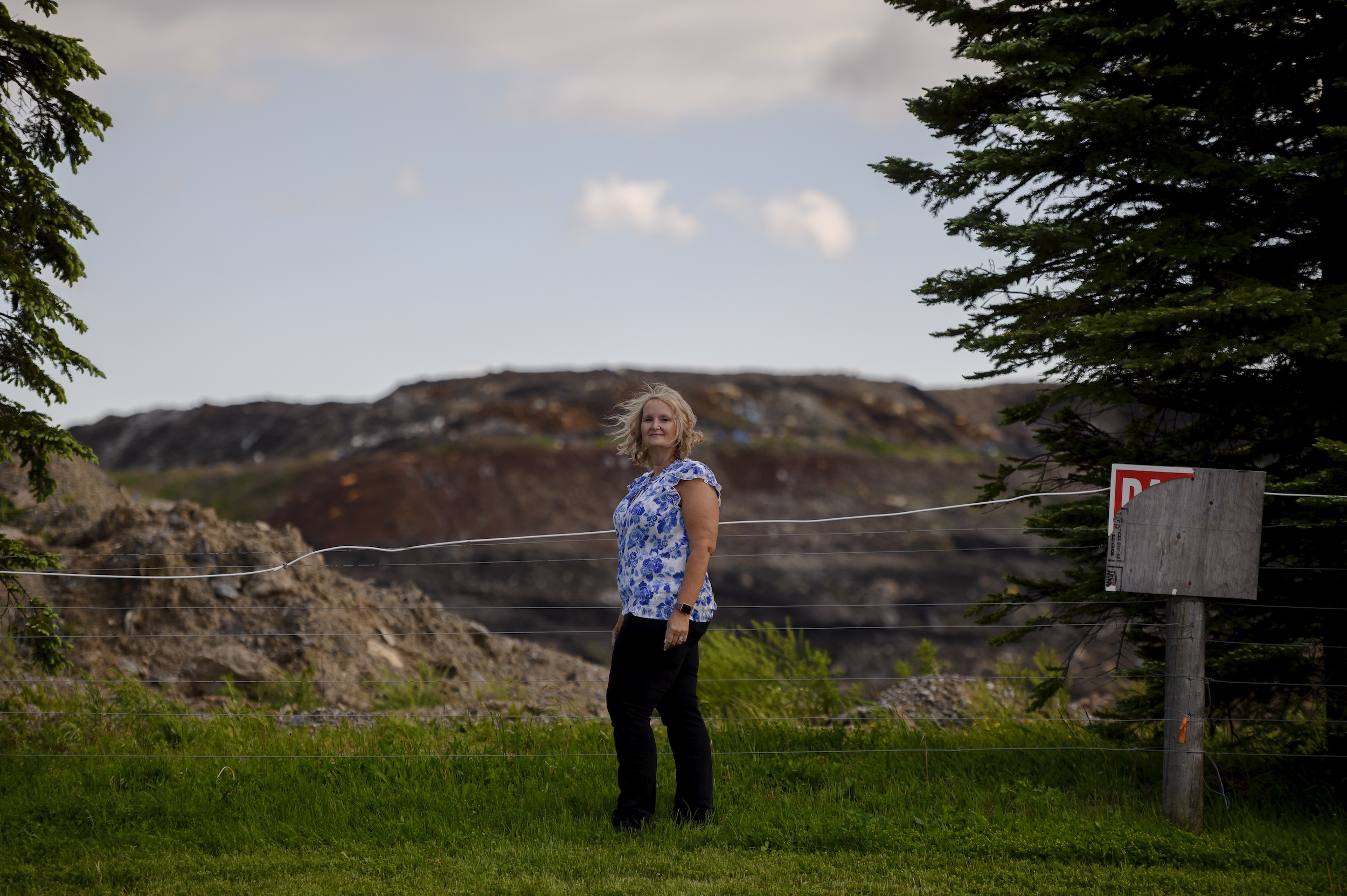
On a brisk afternoon in March, a small group of protestors gathered on the shoulder of Highway 20, at the entrance of GFL’s Stoney Creek landfill in Hamilton. Passing motorists waved and honked as the protestors held up signs that read: “Gag For Life,” “Breathing Shouldn’t Hurt” and “Clean Air Is a Right, Not a Fight.”
Kathie Farraway has been living in this community, surrounded by open fields, for about 25 years. She didn’t even know she was living within hundreds of metres of a landfill until it suddenly started reeking last spring. Farraway says it got so bad, it made her vomit. Her neighbours complained of increased asthma attacks, sore throats and migraines.
The Stoney Creek landfill, which GFL acquired in 2022, is only meant to accept non-hazardous industrial waste, like excavation materials and by-products from steel production. It doesn’t take in garbage, according to its website, “so there are no garbage-related odours.” To be fair, that isn’t untrue; locals say the smell is more of a chemical-like mix of sulphur, gas and cat spray than the rotting-food odour of household garbage.
In an online community meeting late this April, company officials told residents they still didn’t have a “cogent explanation” for what happened last spring, but said that the problem was being taken care of and the number of odour complaints it had received from the community had declined. Construction of a new cell for containing more waste was now underway, they said, and though they were confident they had set up proper measures, they said active landfills generate intermittent odours as part of normal operations. During the Victoria Day weekend, when temperatures climbed into the high 20s, some residents reported the stench had returned.
In a subsequent online community meeting in May, company officials said the landfill was not the cause of the latest stink and emphasized there is no risk of exposure to toxic substances from the landfill.
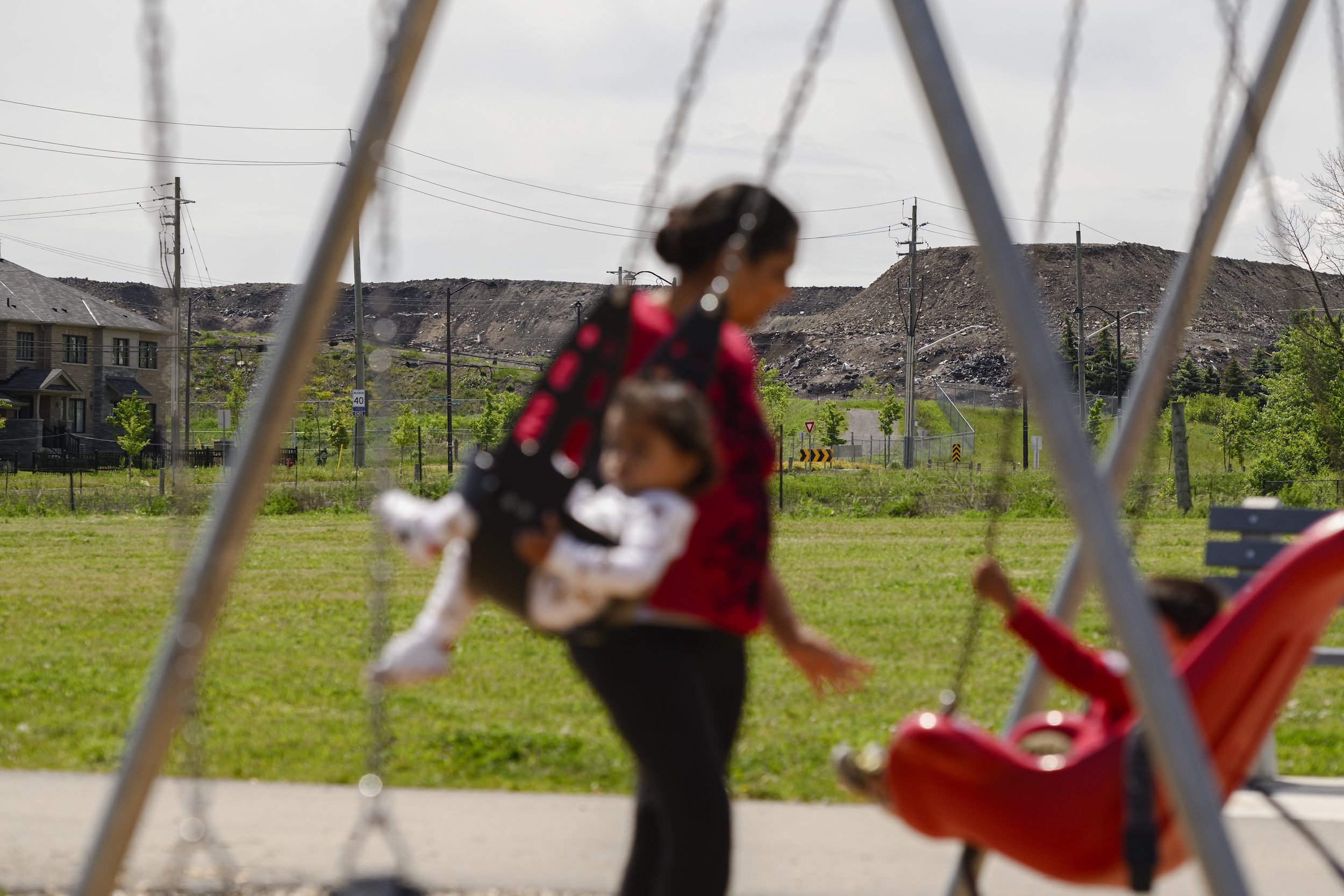
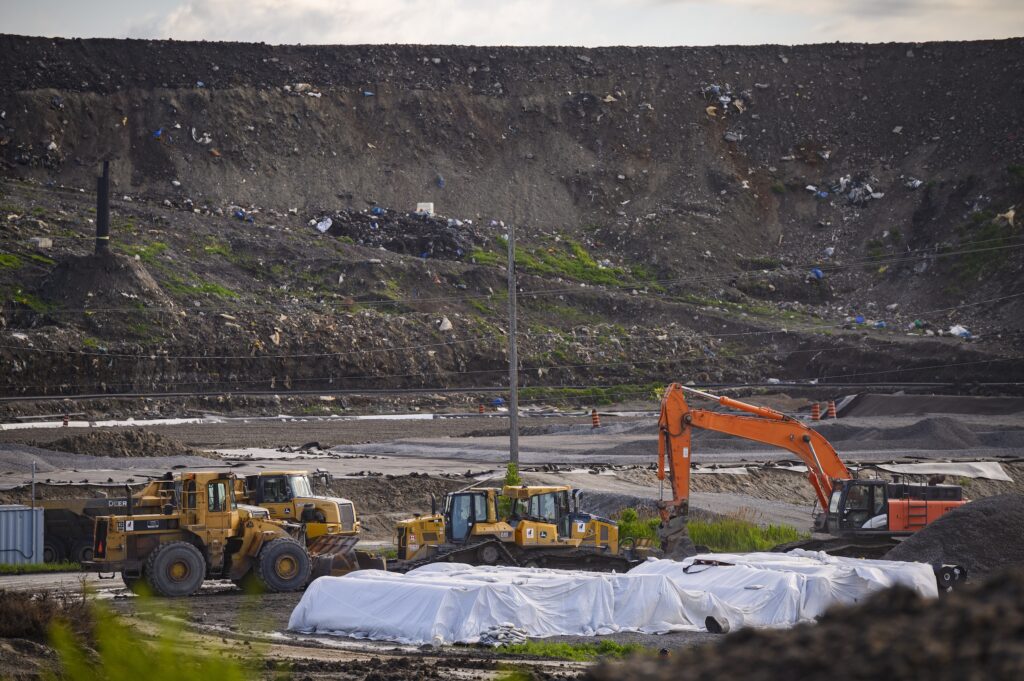
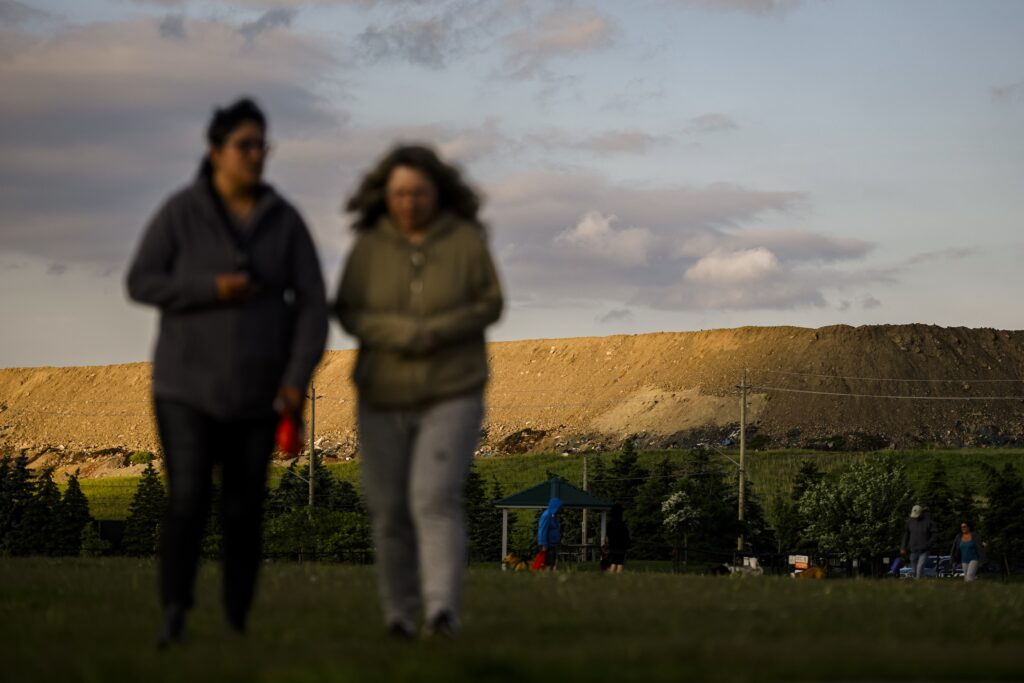
Resident Nelson Faria, however, says his main worry is what will happen years down the road; it’s only then that they’ll find out whether there are any long-term health consequences to whatever they’ve been breathing. “Forget about, you know, the value of your home,” says Faria, a father of three. “It’s your health that is the most concerning thing that we should be confronting.”
For members of The Conservancy Initiative near GFL’s Arbor Hills landfill in Michigan, it’s not just the health of residents that’s a concern, but the health of the ecosystem, too. Through documents acquired through the Freedom of Information Act, the citizens’ group discovered that a stormwater pond at the landfill was being discharged into a spring-fed, cold-water trout stream called Johnson Creek. The documents revealed samples from that pond contained high levels of a type of synthetic, persistent chemicals called per- and polyfluoroalkyl substances, or PFAS. There are thousands of PFAS, which do not break down easily or quickly and are regarded as potentially hazardous to human health. According to Health Canada, they may affect the immune and nervous systems, the liver, kidney and thyroid, and the reproductive system. Despite the finding, no corrective action was taken, The Conservancy Initiative said.
Members of the group, including David Drinan and Leslie Evans, have since periodically collected samples of their own from Johnson Creek, and have had them tested, revealing that the contamination continues.
“It bothers me a lot, because … it’s a great, pristine, water source,” Drinan says. “And I guess I’ll be honest, it annoys me a little bit they’re a Canadian corporation.”
Besides the fact that the landfill is Canadian-owned, close to 25 per cent of the municipal and commercial waste it accepted in 2022 and about 14 per cent in 2023 was actually generated in Canada, according to the Michigan Department of Environment, Great Lakes, and Energy. (Michigan’s governor has recently proposed increasing tipping fees to discourage imported waste from being disposed of in the state.) Ontario landfills are expected to fill up within nine years. Even though major Canadian cities quit sending their waste across the border in 2010, industrial and commercial businesses in Ontario continue to do so, since it’s cheaper to dispose of it in the U.S.
“They bring their trash over from Canada and they’re polluting our resources and nothing’s being done,” Drinan says.
Meanwhile, in Paul Fisher’s neighbourhood in North Carolina, the community is eyeing legal action.
Maia Hutt, lawyer for the Southern Environmental Law Center, has visited the area multiple times. Her client, the non-profit Environmental Justice Community Action Network, is advocating on behalf of the local community.
The intensity of the odour from the Sampson County landfill, located less than a mile from Fisher’s house, depends on which way the wind blows. But it’s noticeable even on “good days,” Hutt says.
More insidious is the pollution of the community’s drinking wells, ground and surface water — including Bearskin Swamp, one of the streams where Fisher used to go hunting and fishing — that is alleged to be linked to the GFL site. In their notice of intent to sue GFL, Hutt and her colleagues pointed out that tests by North Carolina’s Department of Environmental Quality found high levels of PFAS in the groundwater at the landfill, in the surface waters around the landfill and in private well water that residents drink and use for bathing and cleaning. The letter alleged that the landfill has accepted PFAS-laden waste from the DuPont chemical company and its spinoff Chemours for years. (DuPont and Chemours are notorious in the state for releasing PFAS into the environment.)
Though the landfill had been accepting waste from DuPont before GFL acquired it, the letter alleges: “GFL’s handling, storage, treatment and disposal of PFAS-laden sludge and other solid waste has contaminated Bearskin Swamp and residential drinking water wells with toxic PFAS pollution.”
Fisher says many of his neighbours are sick. Some have breathing problems, many rely on kidney dialysis and some have different types of cancer. The Environmental Justice Community Action Network has also heard anecdotal stories from the community about their concerns about chronic illnesses. It’s unknown whether their illnesses are tied to the landfill.
Fundamentally, Hutt says, her clients want clean water — to be able to drink from their wells, and to fish and enjoy Bearskin Swamp again.
“And so, what would be required in order to do that is a full-scale clean-up,” Hutt says. If the contamination were found to be linked to the landfill, she says, “GFL would need to take some accountability and fully investigate and remediate.”
In a later email, Hutt said she and her team were keeping an eye on GFL’s potential buyout. Regardless of whether GFL is acquired, “we will continue to seek justice for our clients,” she said. Hutt added that if GFL was responsible for the contamination, they would not be able to avoid accountability through a buyout.

GFL seems to be well aware that if pressed to clean up its operations, the associated costs could put a dent in its bottom line.
Among its “risks factors,” it stated in its 2022 annual report that it may be liable for damage or the release of pollutants. At times in the past, it said, having to respond to enforcement actions and certain litigation increased its costs and required it to “make significant capital investments” to upgrade its facilities. The company added if it failed to receive various approvals or permits, it could also face hurdles to establishing new or expanding existing facilities.
So far, though, consequences to the company appear to have been relatively mild.
Despite its log of GFL’s non-compliance, B.C.’s Ministry of Environment said by email that it has not issued the company any administrative penalties, explaining “the company has taken those steps to comply with our requirements.”
In Ontario, an Environment Ministry spokesperson directed me to the government’s website for information on convictions for the past five years. I found only two records involving GFL there. One was a $343,000 fine in March 2023 for nine environmental violations, occurring from 2018 to 2020, at sites in Toronto and Dorchester, in Ontario’s Middlesex County. The other was a $130,000 fine this May for violations occurring between April 2020 and November 2021 at its Unwin Avenue waste transfer facility near Toronto’s Cherry Beach. These fines are nominal, compared with GFL’s revenues.
Since the auditor general’s report documenting GFL’s repeat offenses was published in 2021, the ministry said it has granted GFL 49 approvals allowing it to continue or expand its operations. A company’s past history of non-compliance doesn’t result in an automatic denial of its application for approval, the ministry said. Rather, an appointed ministry director makes “site-specific decisions” for each application after a detailed review. In response to questions specifically about the auditor general’s report that GFL had given false test results on fish mortality, the ministry said that the company had confirmed the error was the result of clerical oversight and had rectified the issue. GFL has now become so big, and the sector has become so consolidated, that to some extent we’re all at its mercy. Lakhan, the researcher and scientist at York University, pointed out GFL’s growth has been financed by debt, an issue that has raised questions in the past about the company’s financial position. GFL reported total long-term debt of $8.8 billion for the year ended December 2023. Until recently, S&P Global Ratings gave it a credit rating of BB-, or “junk” status. That was upgraded to B+ this April.
Since the start of 2020, GFL has lost $2.2 billion, The Globe reported, noting it has lately become vulnerable to buyout offers amid investors’ worries about its debt load.
All of this matters for our waste management system because GFL is Ontario’s largest service provider, Lakhan says. “So if they face any economic constraints that threatened the operations of their business, the direct impact is that our waste-handling system begins to fail.”
The last time Torontonians were forced to confront the sheer magnitude of the waste they produce was during the 2009 municipal workers’ strike, when mountains of garbage accumulated in temporary drop-off sites throughout the city, attracting pests and causing an eye-watering stink. It was, perhaps, the closest Toronto got to sampling what Paul Fisher and his neighbours in Sampson County, N.C., report living with on a daily basis.
It’s tempting to turn to recycling as the solution to our waste problem. (GFL, too, has indicated it is looking to grow its recycling business.) But the reality is that recycling isn’t as sustainable or effective as most of us would like to think. A lot of newer packaging materials, such as lightweight plastics, can’t be sorted at conventional recycling facilities, Lakhan explained, which drives up the overall costs. While almost all Canadian households actively recycle, about 70 per cent of the solid waste we generate, including recyclable materials and food waste, end up in landfills anyway. And the savings in carbon emissions aren’t nearly as much as people would expect.
When it comes to encouraging GFL and other waste management companies to cause less pollution, rigorous oversight may be one place to start. Speaking specifically about Ontario, NDP MPP Sandy Shaw, the province’s official opposition environment critic, says when the government shows it doesn’t care about the environment, it sets the tone for everyone else.
“Why would a company comply when the government just basically is turning aside and saying, ‘Well, we’re not really serious about you having to comply?’ ” Shaw says. “Why would a company go the extra mile [when] it costs them money?”
There’s a facet of our waste problem, though, that goes even deeper than the need for stricter regulations and stronger enforcement. It’s the fact we’re producing far too much of it.
The landfills owned by GFL are built to be fed. Every garbage day, a caravan of vivid green GFL trucks make their way across the city, hauling away our empty take-out containers and chip bags, our broken mugs and dryer lint. Once out of our hands, it becomes someone else’s problem. And no matter how green the method of managing it, the environmental impact will be felt someplace else, in the air, the ground or in the water.
GFL’s business is to take our waste and deal with the mess elsewhere. With a burst of green marketing, a company slogan or a sustainability pledge, it can convince us that we can keep creating mountains of garbage, yet still be green for life. And business, so far, shows no sign of slowing.
Get the inside scoop on The Narwhal’s environment and climate reporting by signing up for our free newsletter. On a warm September evening nearly 15...
Continue reading
115 billion litres, 70 years to fix, $5.5 billion in lawsuits

Climate change, geopolitics and business opportunities power a blue economy

10 billion litres of sewage are dumped into Winnipeg’s lakes and rivers each year. Some...
